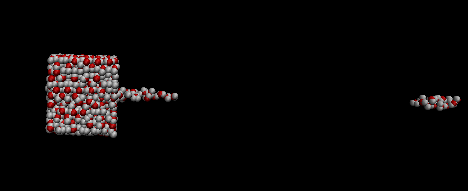Thank you very much for your attention and valuable time. Let me explain the
steps of my procedure as follows
Attaching some pictures helped a lot. Thanks
1- I did the temperature equilibration step just for pool region (I have a
pool region filled with SPC/E water)
Just a comment:
You should eventually equilbrate the system at constant pressure (on
both sides of the nanotube) before running your final simulations.
(I realize this is difficult to do. See below.)
2- After getting equilibrated, I connected a CNT to the pool region
3- Set a non-equilibrium simulation by applying an external force over water
molecules inside the pool just in pore axial direction (Z axis). I have run
the simulation for 1 ns to get steady state.
4- After getting steady-state, I set the simulation for 2 ns to get the
results.
As I mentioned earlier, I am not surprised that water enters the nanotube.
I assume there are graphene walls on either side of the nanotube
similar to these pictures:
http://www.moltemplate.org/images/nanotube+water/nanotube+walls+water_side_pbc_t=0ps.jpg
http://lammps.sandia.gov/user/script8/n30.jpg
If this is correct, then am also not surprised the water stopped
flowing when it reached the end of the tube.
If it were to continue flowing, it would form form a large
surface-area water-vapour interface on the other side of the tube.
Because of surface-tension, this would be energetically unfavorable.
Unless there is also water initially present on both sides of the
nanotube, I don't see how water could flow through the tube unless
absurdly high pressures were applied to force it through.
I suggest you begin the simulation with periodic boundary conditions
and water uniformly distributed on both sides of the tube.
I also suggest that you eventually figure out how to equilibrate your
system under constant pressure. Otherwise, the behavoir you see will
depend on the initial volume you choose. (If it is too large, a
bubble may indeed form in the tube and then no liquid will flow. If
it is too small, it could be bad for other reasons. I imagine you
might get jamming in the tube.) If you just want to get a rough idea
how to do this, get rid of the nanotube and graphene walls, and run a
short simulation to figure out how large a box is necessary to fit
that many water molecules at the desired pressure. Then extend the
periodic boundary conditions to make room for the graphene walls and
the nanotube, and add them back in to your smulation.
Cheers
Andrew
P.S.
If you want to run constant pressure simulations to equilibrate the
volume of the simulation WITHOUT removing the nanotube and graphene
walls, there was a very confusing discussion how to accomplish that
here:
http://www.moltemplate.org/examples/nanotube+water/run.in.npt
(Unfortunatley, "fix rigid" has changed greatly since then, and I
don't know if these commands still work. This entire approach might
not even work, assuming it ever did. But at least it would get you
started thinking about the issues involved.)

